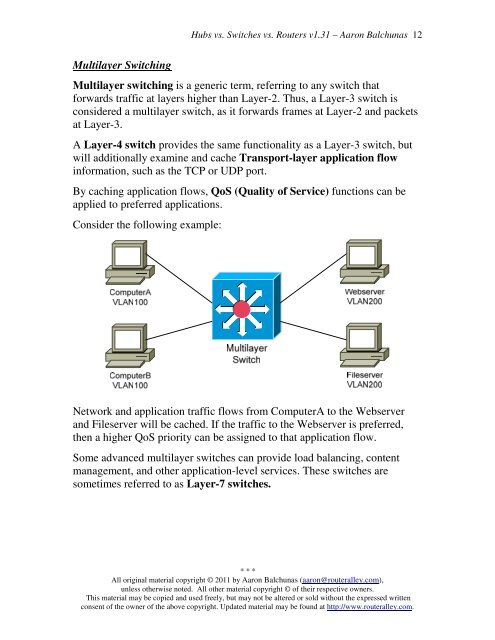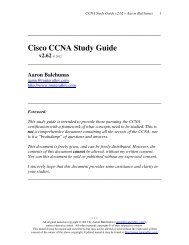Hubs vs. Switches vs. Routers - Router Alley
Hubs vs. Switches vs. Routers - Router Alley
Hubs vs. Switches vs. Routers - Router Alley
You also want an ePaper? Increase the reach of your titles
YUMPU automatically turns print PDFs into web optimized ePapers that Google loves.
Multilayer Switching<br />
<strong>Hubs</strong> <strong>vs</strong>. <strong>Switches</strong> <strong>vs</strong>. <strong><strong>Router</strong>s</strong> v1.31 – Aaron Balchunas 12<br />
Multilayer switching is a generic term, referring to any switch that<br />
forwards traffic at layers higher than Layer-2. Thus, a Layer-3 switch is<br />
considered a multilayer switch, as it forwards frames at Layer-2 and packets<br />
at Layer-3.<br />
A Layer-4 switch provides the same functionality as a Layer-3 switch, but<br />
will additionally examine and cache Transport-layer application flow<br />
information, such as the TCP or UDP port.<br />
By caching application flows, QoS (Quality of Service) functions can be<br />
applied to preferred applications.<br />
Consider the following example:<br />
Network and application traffic flows from ComputerA to the Webserver<br />
and Fileserver will be cached. If the traffic to the Webserver is preferred,<br />
then a higher QoS priority can be assigned to that application flow.<br />
Some advanced multilayer switches can provide load balancing, content<br />
management, and other application-level services. These switches are<br />
sometimes referred to as Layer-7 switches.<br />
* * *<br />
All original material copyright © 2011 by Aaron Balchunas (aaron@routeralley.com),<br />
unless otherwise noted. All other material copyright © of their respective owners.<br />
This material may be copied and used freely, but may not be altered or sold without the expressed written<br />
consent of the owner of the above copyright. Updated material may be found at http://www.routeralley.com.

















